There are hundreds, if not thousands of marine fish in the trade. Some of these fish cost thousands of dollars. Others are sensitive to even small shifts in water parameters. But which of these are the best saltwater fish for beginners?
Criteria For the Best Saltwater Aquarium Fish For Beginners
Here are the main criteria I used to decide on which were the best saltwater fish for beginners:
- Inexpensive: Most of the saltwater fish here are on the inexpensive side of the trade. The Four Stripe Damselfish is the best value and can be found for as little as $4.99 in stores. Adult Flame Angelfish and Black Cap Basslets can set you back $45-60 but are still inexpensive, as saltwater fish go.
- Hardy: Many saltwater fish are difficult to feed or provide good water quality for. Some are sensitive to temperature, salinity, or pH changes. A few are picky eaters, like Angelfish and Tangs. The majority accept a wide variety of prepared and frozen offerings and are not too sensitive to water conditions so long as they are stable and clean.
- Small to Medium Sized: Beginner saltwater aquarists don’t buy 300+ gallon setups. And unfortunately, many of the marine fish you’ll find in local pet stores will outgrow the average tank. Each one of the fish I chose below will do well in aquariums ranging from 10 to 100 gallons in volume.
Keep in mind that other criteria such as aggressiveness, reef-safety, activity level, or a predatory nature may disqualify a particular fish from your aquarium plans.
Damselfish
Damselfish are very often one of the first first that new saltwater aquarium owners purchase. This section dives into a few common damselfish species:
Common Clownfish
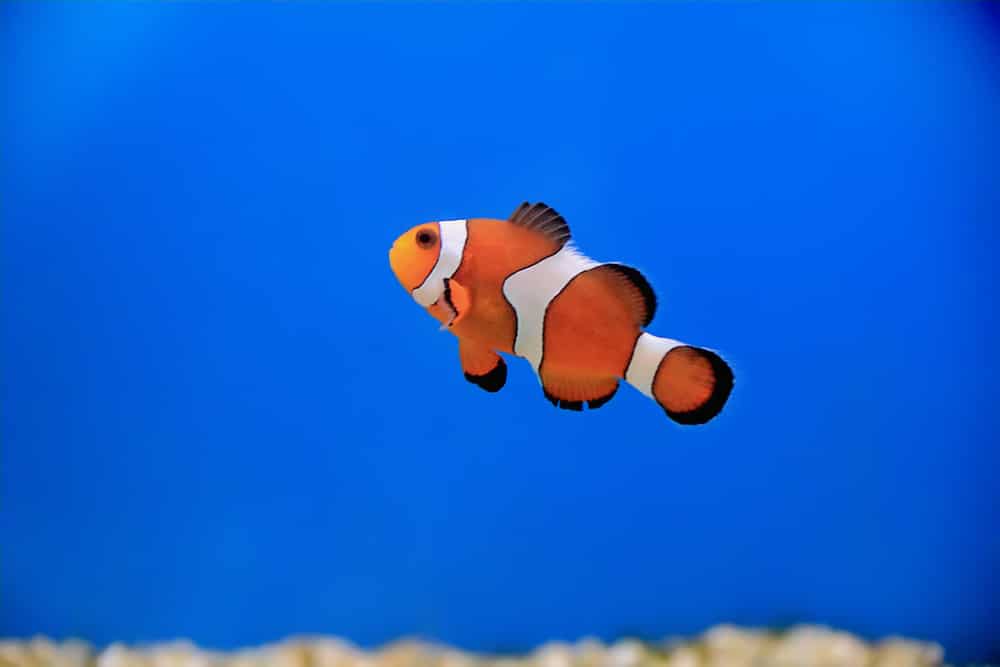
Beginner saltwater aquarists looking for their “Nemo” have come to the right place. There are actually two species of clownfish to look at; the Ocellaris or Common Ocellaris Clownfish (Amphiprion ocellaris), and the Percula Clownfish (Amphiprion percula).
Both of these small saltwater fish look almost identical. The Common Clownfish has thinner black lines, 11 dorsal fin spines, and more dark pigmentation in the eyes. Percula Clownfish are smaller, more expensive and more sensitive to poor water conditions. Making them ideal for intermediate to advanced hobbyists.
Anemones are half the fun of keeping Clownfish. Due to a mutually symbiotic arrangement, Clownfish nestle among the stinging tentacles of the anemone for protection. In exchange the Clownfish will drop bits of food directly onto its mouth and defend it from potential predators.
Common Clownfish don’t need to be kept with anemones, though. Anemones have specialized needs in terms of water quality and lighting. They are often challenging and expensive for beginners to keep alive.
Common Clownfish will thrive in saltwater fish-only community tanks of at least 20 gallons. Alongside peaceful species and plenty of live rock to dart in and out of. They are active, hardy carnivores and accept a wide range of prepared foods mixed with meaty frozen and live items.
- Scientific Name: Amphiprion ocellaris
- Length: 3-4 inches
- Temperament: Peaceful
- Aquarium Size: 20 gallons
- Reef Safe: Yes
Blue Reef Chromis
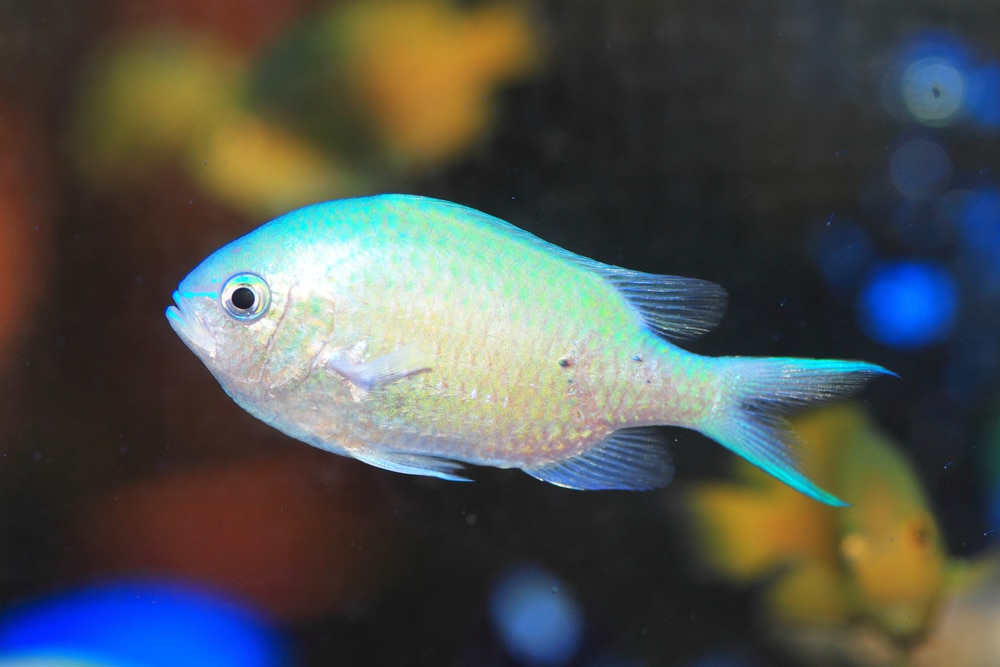
These Caribbean Damselfish are an intense, iridescent blue and need to be kept in schools of around 6 individuals. Damselfish of all kinds are hardy, eager feeders, and some of the best small saltwater fish for beginners.
Chromis in particular are a great choice because they are less aggressive compared to most of their Clownfish and Dascyllus sp. cousins.
Blue Reef Chromis tend to hang in the middle to upper water column, near prominent coral outgrowths. As zooplankton feeders they prefer to pick out smaller food particles from the water as it flows by – a surface to mid level powerhead gives them current to swim against and dart into for food
Like most saltwater pets that eat zooplankton, Blue Reef Chromis are reef-safe and won’t pick at corals or invertebrates. This habit makes them ideal dither fish for the saltwater aquarium because they help shy fish feel at ease.
Chromis Damselfish as a whole are hardy and inexpensive. Perfect qualities for the best fish for saltwater tank cycling. While unaggressive, they will set up a pecking order amongst themselves. So long as they are kept in moderately sized groups no one member will be harassed to death.
- Scientific Name: Chromis cyaneus
- Length: 4 to 5 inches
- Temperament: Peaceful, Schooling
- Aquarium Size: 30 gallons
- Reef Safe: Yes
Four Stripe Damselfish
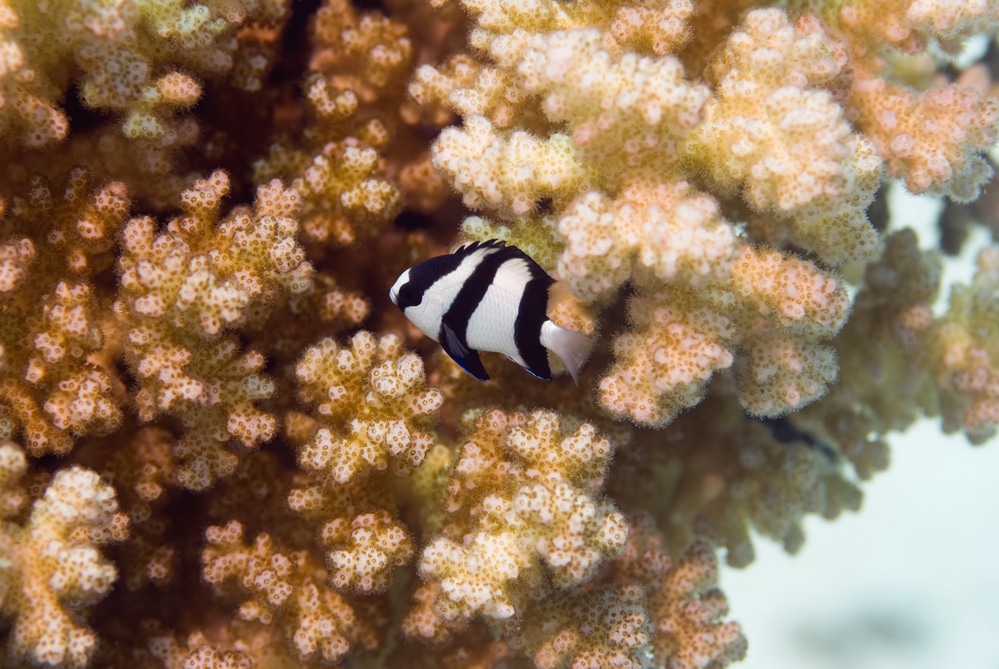
Four Stripe Damselfish are some of the best saltwater fish for beginners. But they do come with a few challenges. They are aggressive and territorial as they grow older. Both towards their own kind and other starter saltwater fish.
On the plus side, they have a bold black and silver pattern that’s eye-catching. Plus they are resilient in terms of water quality shifts. Four Stripe Damselfish will eat any sort of carnivorous food offering. They are also reef-safe saltwater fish types, offering a stark color contrast to the pinks, greens, and purples of coral and live rock.
Four Stripe Damselfish will usually claim a rocky outcropping as their territory and will nip at any intruders. When kept in tanks smaller than 30 gallons this territory can extend to most of the aquarium. Tank mate deaths may occur due to stress from these aggressive damselfish.
Instead of pairing these aggressive little fish with peaceful tank mates, choose similar sized to larger fish that are on the semi-aggressive spectrum. But be careful that any tank mates won’t be able to eat them. Angelfish, smaller Triggerfish, Dottybacks, and Wrasses are a good match both in size and temperament.
By the way, all Four Stripe Damselfish are female unless kept in groups. Through social dynamics dominant fish will become males and then court the other females of his new harem.
- Scientific Name: Dascyllus melanurus
- Length: 3-4 inches
- Temperament: Aggressive, Territorial
- Aquarium Size: 30 Gallons
- Reef Safe: Yes
General Damselfish Notes
- Damselfish are active, often aggressive salt water tank fish that tend to stake out territories and defend them vigorously.
- Many Clownfish and Chromis are gentler and peaceful. While larger Clownfish and Dascyllus Damselfish tend to be the most aggressive.
- Damselfish are hardy when it comes to water quality and will accept nearly any prepared or frozen food item.
Angelfish
Saltwater Angelfish are, undoubtedly, one of the most attractive groups of saltwater aquarium fish. This section dives into a few species of Angelfish that you can keep at home.
Flame Angelfish
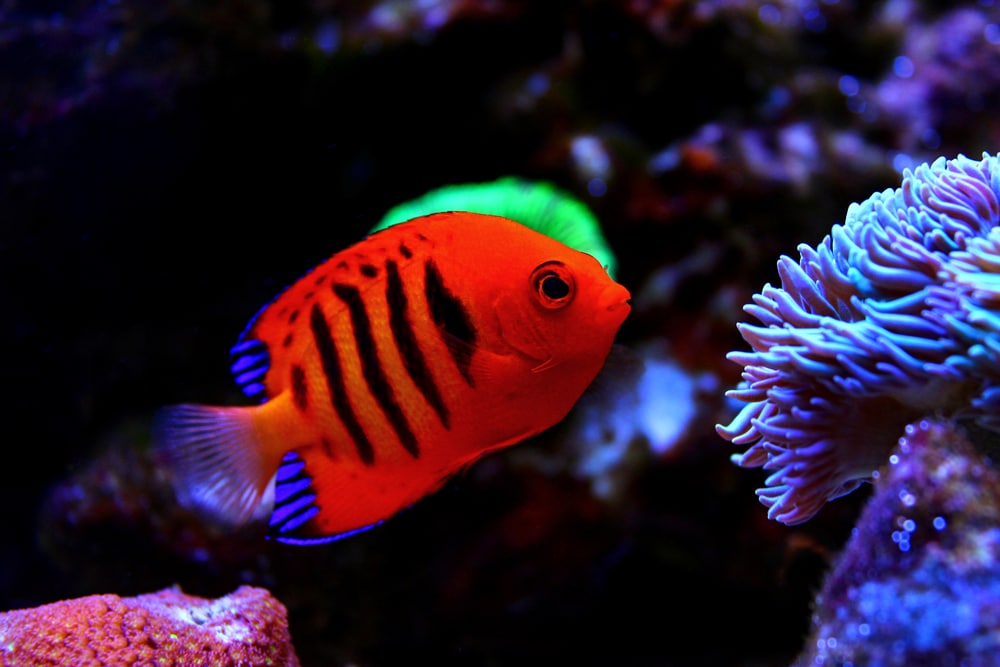
Flame Angelfish are community saltwater fish with some of the most intense colors. Angelfish in general are beautiful. But as a dwarf species, Flame Angels are smaller, less specialized, and easier to care for than their larger cousins.
Flame Angelfish are good marine fish for beginners because they feed on algae and small invertebrates. Most of their larger cousins feed on sponges, which gets expensive fast. Flame Angelfish will take vegetarian flake food mixed with occasional snacks of protein rich flakes or frozen food.
While Flame Angelfish are hardy as Angelfish go they should be some of the last fish to introduce to your new saltwater aquarium. Once the tank is mostly cycled you will have little trouble with them. They are also peaceful as far as Angelfish go – Flame Angelfish may claim a small territory but aren’t nearly as aggressive as other species.
No Angelfish is 100% reef-safe. Nearly all species are grazers of live rock, feeding on algae, bryozoans, sponges, and corals. Flame Angelfish are mostly algae feeders and are one of the best Angelfish to consider for a reef aquarium. However there’s always a chance of one taking a liking to a soft coral or clam mantle.
- Scientific Name: Centropyge loriculus
- Length: 3 to 4 inches
- Temperament: Peaceful, occasionally Territorial
- Aquarium Size: 20+ Gallons
- Reef Safe: Somewhat
Bicolor Angelfish
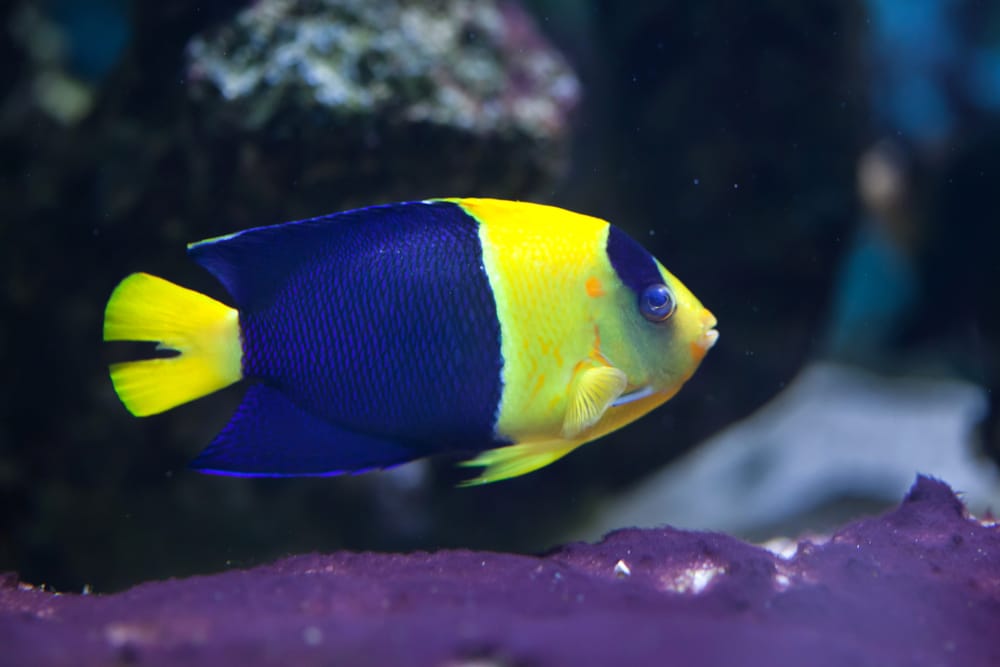
Bicolor Angelfish are some of the largest of the Centropyge Dwarf Angelfish, reaching almost 6 inches in length. They are also on the more aggressive end, particularly towards other Angelfish.
That said, you can minimize how aggressive this beginner saltwater fish is by providing a spacious tank. Add plenty of live rock outcroppings to break line of sight so the Angelfish can establish a territory.
Like most omnivorous species Bicolors are easy to feed saltwater fish for beginners. But they are not reef-safe because they graze all of the time. They will find many sessile invertebrates delicious.
Bicolor Angelfish are inexpensive and easy to find tropical saltwater fish. But they are a little on the sensitive side in terms of hardiness. The tank should be allowed to fully cycle and they should be the last fish added to it.
- Scientific Name: Centropyge bicolor
- Length: Up to 6 inches
- Temperament: Semi-aggressive
- Aquarium Size: 55 Gallons
- Reef Safe: No
Rock Beauty Angelfish
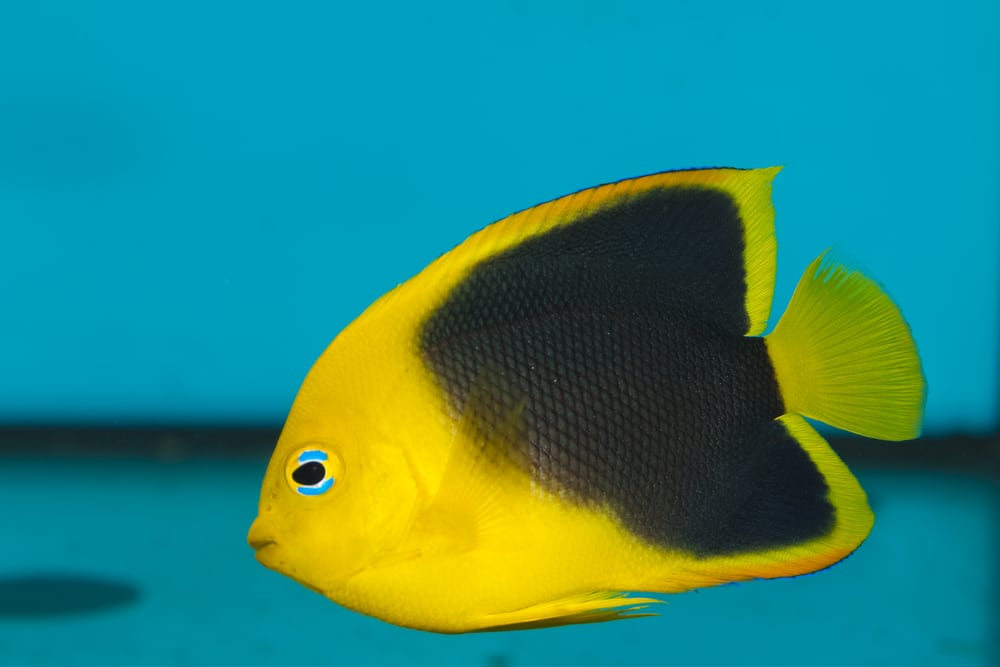
Rock Beauty Angelfish are a good beginner saltwater fish if you’re looking for a larger marine fish species. Reaching up to 10 inches in length, these Atlantic Holacanthus Angelfish are specialist sponge feeders. That means you’ll need to purchase large quantities of frozen marine Angelfish preparation. Mixed with Spirulina flakes and frozen meaty fare.
Choosing tankmates for them can be a bother because Rock Beauties are semi-aggressive. Yet have no tolerance for aggressive tank mates.
They must be the most dominant fish or they will be stressed by the conflict. Fast swimming, peaceful tank mates like Blue Reef Chromis, Tangs, and bottom dwellers like Gobies are great additions.
So long as they are properly fed and their tank mates are on the passive side, Rock Beauty Angelfish are hardy in terms of water quality. Plus they are large and impressive-looking without being true tank busters.
- Scientific Name: Holacanthus tricolor
- Length: Up to 10 inches
- Temperament: Semi-aggressive
- Aquarium Size: 75 Gallons
- Reef Safe: No
General Angelfish Notes
- Angelfish tend to have specialized diets high in either algae or sponges that need to be accounted for.
- Even the most peaceful Angelfish tend to be territorial of both each other and other fish and should be given space for territories and breaks in line of sight.
- Angelfish are not the easiest saltwater fish for beginners. They should be the last fish to add to an aquarium in the process of being cycled.
Tangs
Tangs are popular for their bright colors are unique traits, but they can be a bit more challanging than the other species on our list.
If you already have a bit of experience with saltwater fish-keeping, here are a few tang species that you should look into:
Yellow Tang
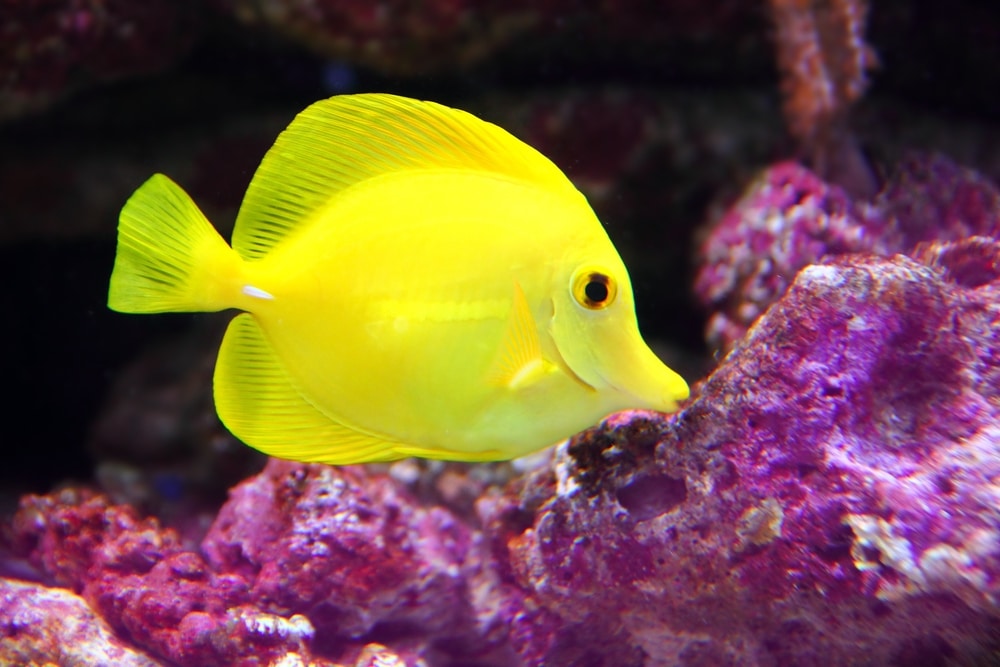
Yellow Tangs are bright lemon colored vegetarians that are reef safe and provide a service by browsing continually on filamentous algae that competes with corals and anemones for light and nutrients.
When purchased young, Yellow Tangs can even be raised in groups that will form a school as they mature. They are also peaceful and won’t bother tank mates. That said, you should be aware that aggressive tank mates may find Surgeonfish problematic.
Surgeonfish get their name from a retractable jackknife-like barb along the tail. When threatened, Tangs and Surgeonfish flick this barb at their assailants. Which will open up deep gashes that may lead to infection.
While they are somewhat hardy, Yellow Tangs are sometimes the canary in the coal mine when water quality drops. Tangs and Surgeonfish are prone to Head and Lateral Line Erosion Disease (HLLE), also known as “Hole in the Head.”
Under no circumstances should you buy a Tang in the store displaying gouges of missing skin or flesh along the lateral line. While the causes are not entirely known, poor nutrition and water quality are thought to be the main reasons. Vitamin C (found in vegetable matter) is also thought to alleviate the disease.
- Scientific Name: Zebrasoma flavescens
- Length: Up to 8 inches
- Temperament: Peaceful
- Aquarium Size: 55 Gallons
- Reef Safe: Yes
Blue Tang
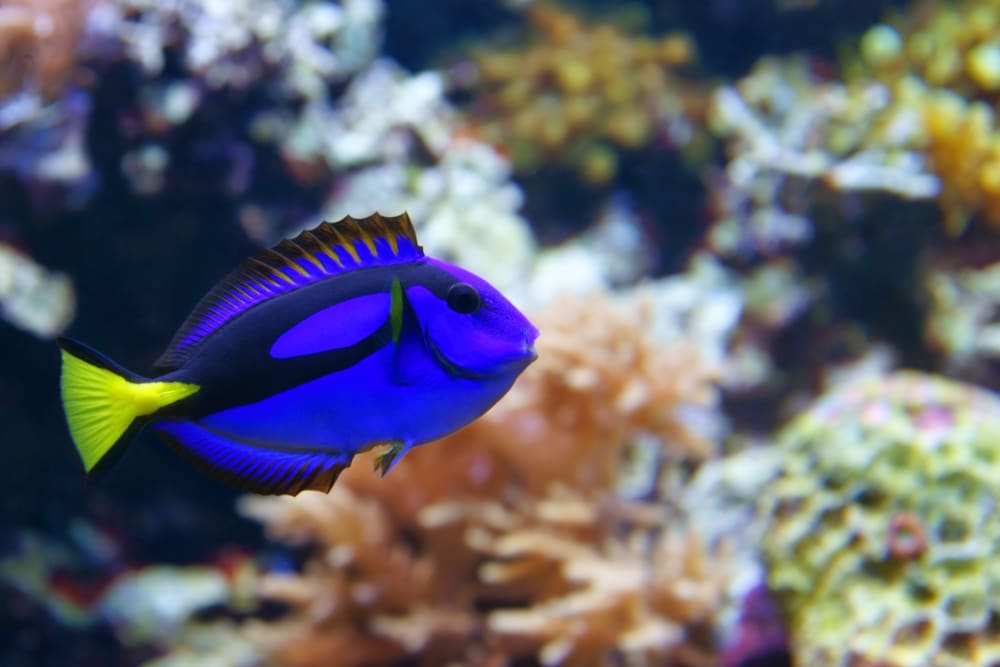
Also known as the Hippo Tang or Blue Surgeonfish, Blue Tangs are the Dory to your Nemo. They are salt water fish pets that eat a fair amount of zooplankton as well as the usual algae and seaweed that all Tangs love. Offer them Mysis and Brine Shrimp in addition to vegetarian fare for best health and color.
Blue Tangs are active and peaceful towards other fish but aggressive and intolerant of both their own kind and other Tangs. They are also a larger type of saltwater fish, reaching up to 12 inches in length. So long as your tank can accommodate one, they are showy, reef-safe inhabitants.
Like all Tangs and Surgeonfish, Powder Blue Tangs may show symptoms of HLLE if fed standard animal-based fish food. Offer a diverse range of seaweed, Spirulina flakes, and even blanched vegetables like Cauliflower and Spinach to ensure they get enough vitamins.
- Scientific Name: Paracanthurus hepatus
- Length: 10 to 12 inches
- Temperament: Peaceful to Semi-aggressive
- Aquarium Size: 100 Gallons
- Reef Safe: Yes
Kole Tang
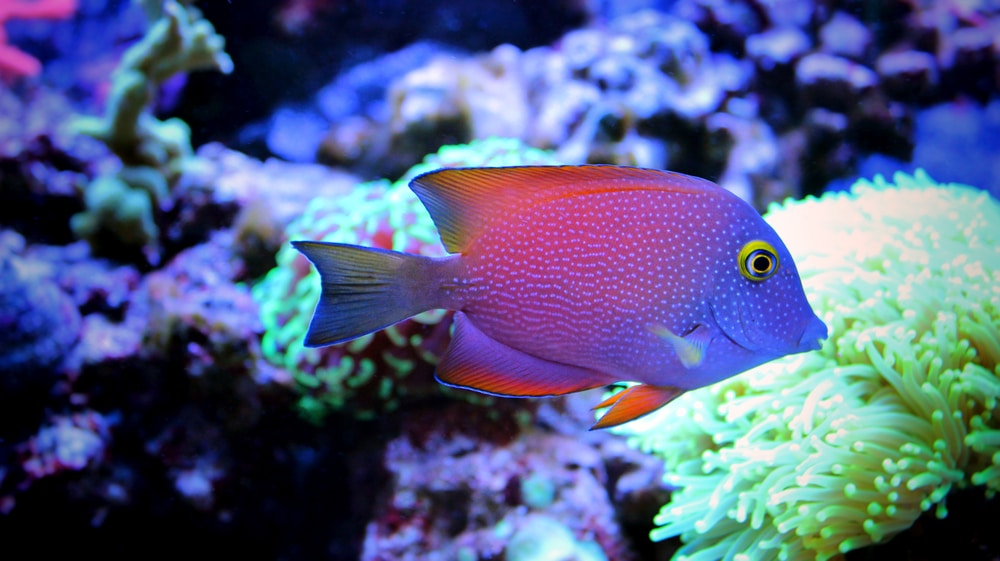
Kole Tangs are a great addition to reef tanks with algae issues because they eat a wide range of types, including brown diatomaceous algae. While often considered herbivores, Kole Tangs are better classified as “detritivores.”
They feed on the debris that coats live rocks. In the process they consume algae, tiny invertebrates, diatoms, protozoans, and other minute creatures that coat any surface in a mature aquarium. Kole Tangs will even graze on aquarium glass and equipment. Helping to keep your tank looking clean.
Kole Tangs are gentle and can even be kept with other Tangs. But you’ll want to keep a close eye on them both because other Tangs are not so forgiving. When paired with gentler species that feed on different algae species like Yellow Tangs, they form an algae-busting duo that’s hard to match.
- Scientific Name: Ctenochaetus strigosus
- Length: 7 inches
- Temperament: Peaceful
- Aquarium Size: 70 Gallons
- Reef Safe: Yes
General Tang Notes
- Tangs prefer moderate current, especially Blue Tangs.
- Tangs are partial vegetarians and need vegetable matter to avoid diseases due to vitamin deficiencies.
- While intolerant of each other, Tangs are peaceful, reef-safe fish. Watch for their retractable tail blades that they will use both against aggressive tank mates and when netted.
Bass and Basslets
In this section we discuss a few unique bass and basslet species:
Chalk Bass
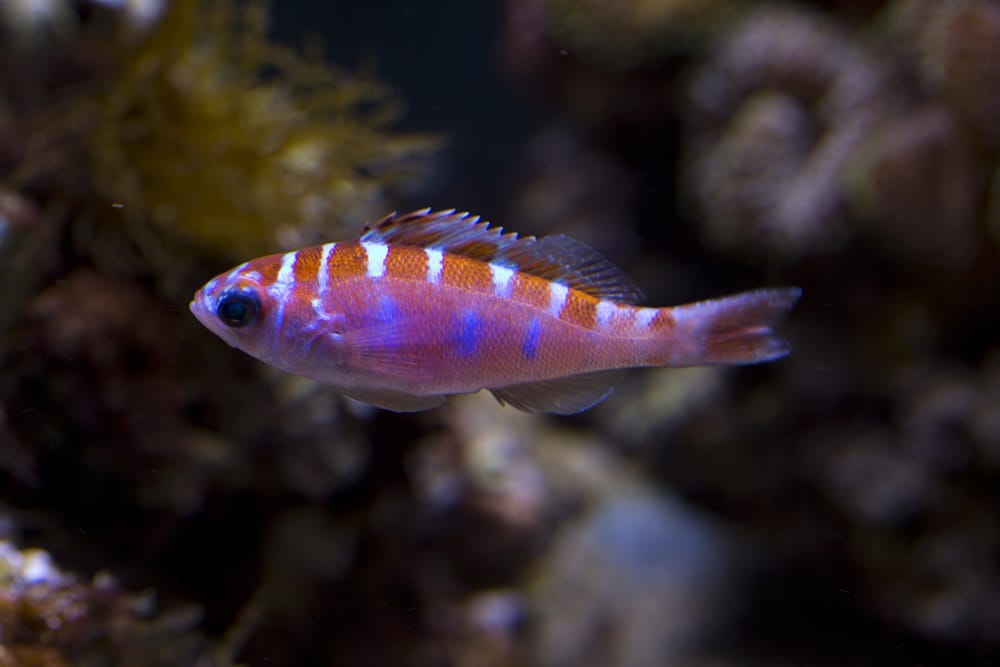
The Chalk Bass is an often overlooked choice that is one of the easiest saltwater fish for beginners! As its name suggests, it’s in the same family as Sea Bass and even the Giant Grouper, one of the largest bony fish in existence.
Chalk Bass are predators but they only feed on zooplankton, tiny invertebrates, fish fry, and other small prey items. They reach full size at 2 to 3 inches in length as well.
These small saltwater fish are excellent community tank dwellers and reef-safe. Though you should be careful of keeping them with the smallest of reef shrimp. Even tiny crabs are far too crunchy to be a meal for Chalk Bass.
Chalk Bass are also sociable, forming small shoals in the wild. Allow for 10 gallons of space per Chalk Bass you intend to keep. They also make great nano-reef inhabitants. Their relatively unflashy colors and abundance in North American Atlantic waters makes them inexpensive and easy to obtain.
When first introduced, Chalk Bass tend to be shy and will stay hidden. But dither fish, ample hiding places, and treats of live and frozen food will soon encourage them to stay out in the open. Chalk Bass are hardy, peaceful, and overall one of the best saltwater fish for beginners!
- Scientific Name: Serranus tortugarum
- Length: 2 to 3 inches
- Temperament: Peaceful
- Aquarium Size: 10 gallons
- Reef Safe: Yes
Royal Gramma
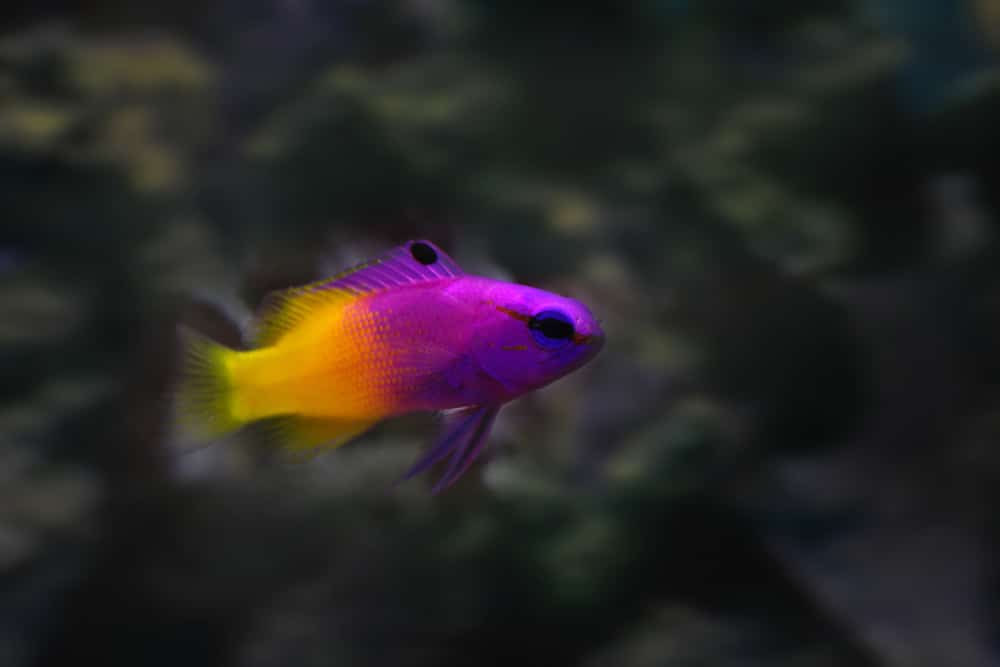
Royal Gramma are iconic saltwater fish seen regularly in the pet trade. These Caribbean Basslets are hardy, easy to feed, and inexpensive. They stay small, maxing out at around 3 inches, and are zooplankton feeders in nature.
Royal Gramma are peaceful but should absolutely be kept alone in all but the largest of aquariums and be given a small cave. Like most Basslets they will claim a small hollow and defend it vigorously from intruders.
Aquariums with lots of live rock that forms nooks and crannies are best. They will dart from their chosen cave to snap up Brine Shrimp, Bloodworms, and floating prepared foods before quickly returning home.
So long as other fish don’t try to push them out, Royal Grammas are model community citizens. But tank mates that become too curious about their home may suffer a nip or get chased. They are also intolerant of other Royal Gramma unless kept in large tanks (55+ gallons) where they can claim caves without seeing each other often.
In very large aquariums (100+ gallons) you can try keeping a harem. Like many saltwater fish pets, Royal Gramma are all female until social dynamics induces the dominant fish to become a male. Males are larger and have even stronger colors.
- Scientific Name: Gramma loreto
- Length: 2 to 3 inches
- Temperament: Peaceful; Territorial
- Aquarium Size: 20 Gallons
- Reef Safe: Yes
Black Cap Basslet
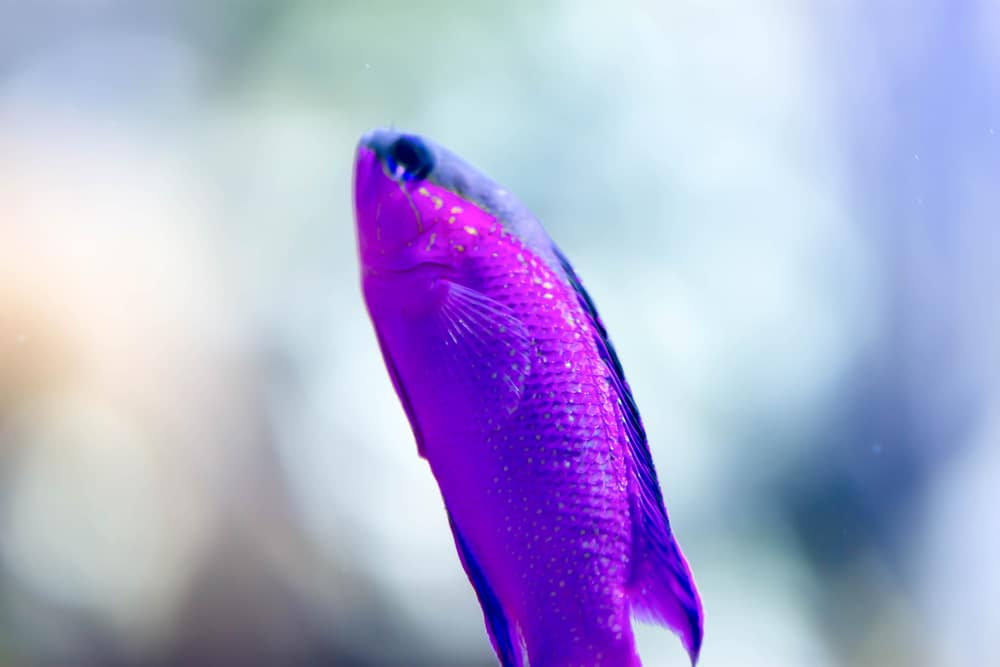
The Black Cap Basslet is a close cousin of the Royal Gramma that grows a little larger. It is rarer in the aquarium trade since it is found in deeper water. Being rarer makes them more expensive but rarely over $50.
Black Cap Basslets have identical care requirements to the Royal Gramma and are just as hardy. The deep purple coloration with a darker purple forehead is remarkable and just as eye-catching as the Royal Gramma’s half and half coloration.
Being a bit larger than Royal Gramma, be certain any reef invertebrates aren’t tiny enough to be consumed. Otherwise it is an excellent beginner reef fish.
- Scientific Name: Gramma melacara
- Length: 3 to 4 inches
- Temperament: Peaceful; Territorial
- Aquarium Size: 30 Gallons
- Reef Safe: Yes
General Bass and Basslet Notes
- Dwarf Bass and Basslets feed on zooplankton and tiny invertebrates, making them safe additions to any fish aquarium.
- Bass and Basslets are reef-safe and won’t attack larger invertebrates.
- Chalk Bass are sociable and schooling but Basslets are territorial and will fight one another in smaller aquaria. There are several available species of Dwarf Bass in the trade so do your research. Some species (like the Harlequin Bass – Serranus tigrinus) will grow large and are solitary, semi-aggressive predators.
Other Great Saltwater Aquarium Fish
Here are a few other saltwater fish species that you should consider when setting up your tank:
Fire Goby
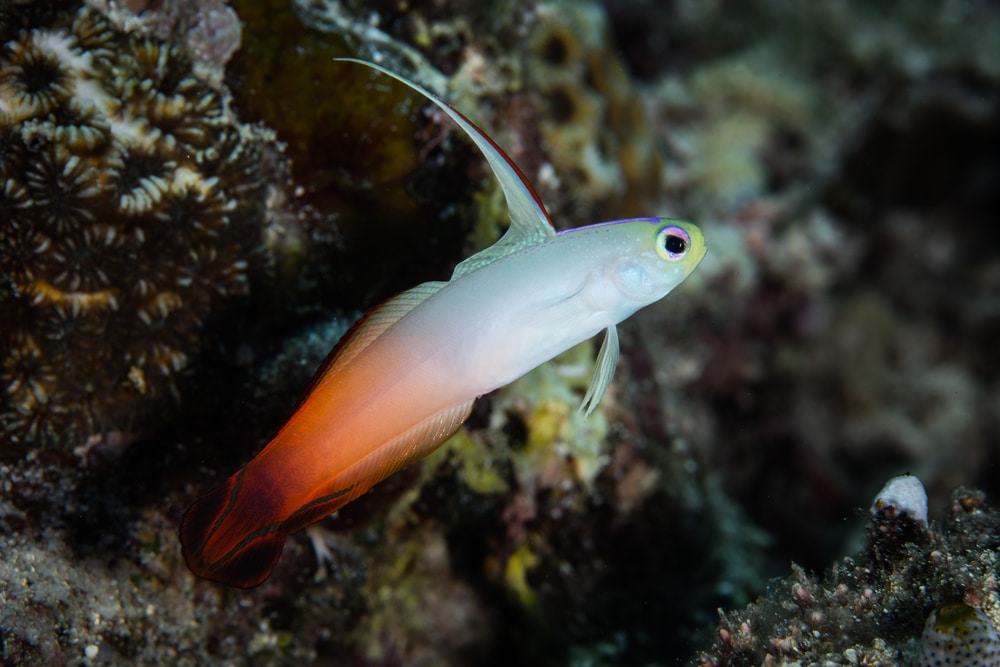
Also known as the Firefish or Magnificent Dartfish, these are one of the more striking saltwater fish for beginners. Found in the Indopacific region from East Africa all the way to Hawaii, Dartfish get their name from their habit of darting to cover among rubble and coral when threatened.
Fire Gobies are planktivores, feeding on floating plankton and crustaceans that waft by their chosen burrows. They have similar behavior patterns to Basslets in that they will claim a hiding place and hover around the immediate area. Only leaving to feed but quickly returning if feeling exposed.
Baby and adult Brine Shrimp and similarly sized frozen items along with prepared flake and pellets are eagerly accepted.
Unlike some cave dwellers, Fire Gobies are not territorial and may be bullied from their chosen hiding place. If kept with other cave dwellers like Basslets you should ensure there are plenty of places for hiding in case the Fire Gobies get kicked out.
Fire Gobies are territorial towards one another and should only be kept together in tanks larger than 55 gallons.
- Scientific Name: Nemateleotris magnifica
- Length: Up to 3 inches
- Temperament: Peaceful
- Aquarium Size: 20 Gallons
- Reef Safe: Yes
Pajama Cardinalfish
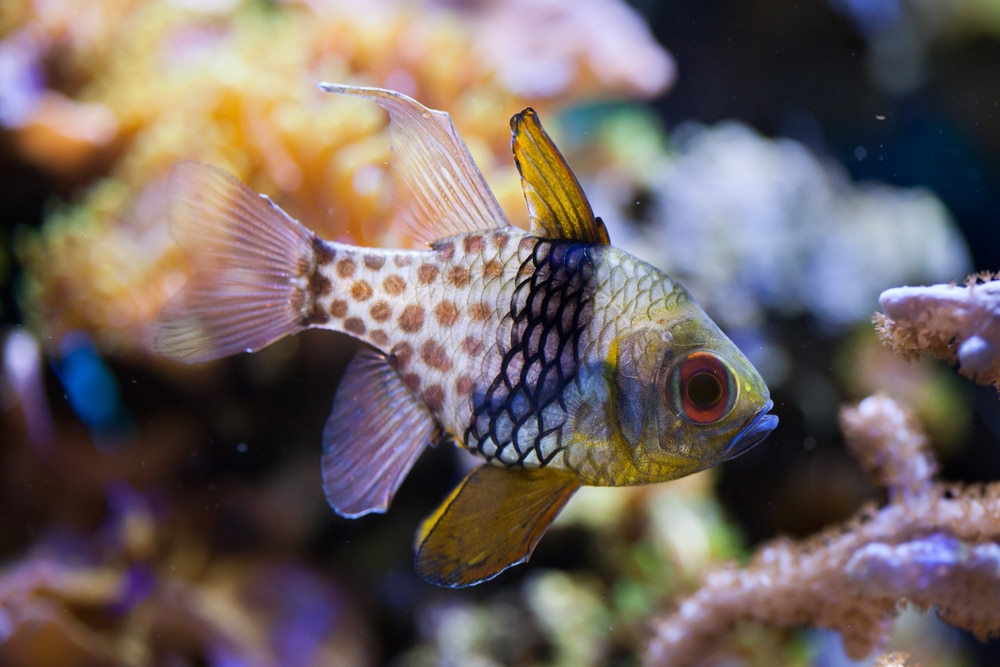
Cardinalfish are schooling fish with striking patterns found throughout the Western Pacific Ocean. Pajama Cardinalfish are some of the most unusual looking easy saltwater fish to take care of. Their huge red eyes, black strike, and polka dot rear half are like no other marine fish..
Many species of Cardinalfish, including this one, school together among the spines of sea urchins, particularly the long-spined venomous Diadema species. Unlike Clownfish the Cardinalfish offer no benefit to the Sea Urchin and are probably not even noticed. But they cause it no harm, either.
Cardinalfish are some of the best saltwater fish for beginners. While shy at first and reluctant feeders they will be tempted with live and frozen foods. You will eventually wean them onto prepared foods.
When kept in schools they become much more personable and bold. They will swim in open water and even start displaying to one another.
Other Cardinalfish that are some of the best starter saltwater fish include the Banggaii Cardinalfish (Pterapogon kauderni) and Flame Cardinalfish (Apogon maculatus). Both are also schooling, peaceful community dwellers that reach 3 inches in length.
- Scientific Name: Sphaeramia nematoptera
- Length: 3 inches
- Temperament: Peaceful; Schooling
- Aquarium Size: 20 Gallons
- Reef Safe: Yes
Longnose Hawkfish
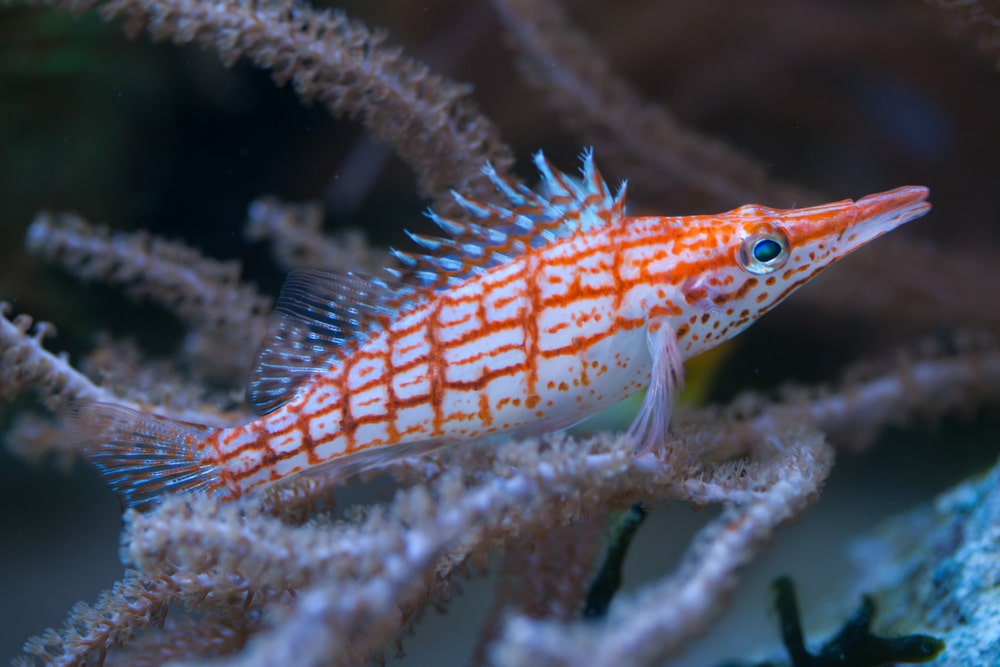
Longnose Hawkfish are unusual community saltwater fish found across the Indopacific region. Rather than swim around actively they perch on rock and coral outcroppings waiting for small fish and invertebrates to wander too close, hence the name “Hawkfish.”
They are predatory and able to eat tiny tank mates. But Longnose Hawkfish have small mouths and aren’t a threat to same sized fish and large invertebrates. They are territorial however. Hawkfish will choose a perch and chase fish away with similar habits like Flame Hawkfish, Gobies, and other sedentary fish.
Longnose Hawkfish are somewhat reef safe but need to be considered with care. Their perching habits can make them irritating to corals. Which causes them to close up whenever the Longnose Hawkfish decides to sit.
Hawkfish may also receive strings from anemones when trying to find a spot to perch. Also, smaller shrimp are one of their favorite things to eat.
- Scientific Name: Oxycirrhites typus
- Length: Up to 5 inches
- Temperament: Predatory; Territorial
- Aquarium Size: 55 Gallons
- Reef Safe: With Caution
Dwarf Lionfish
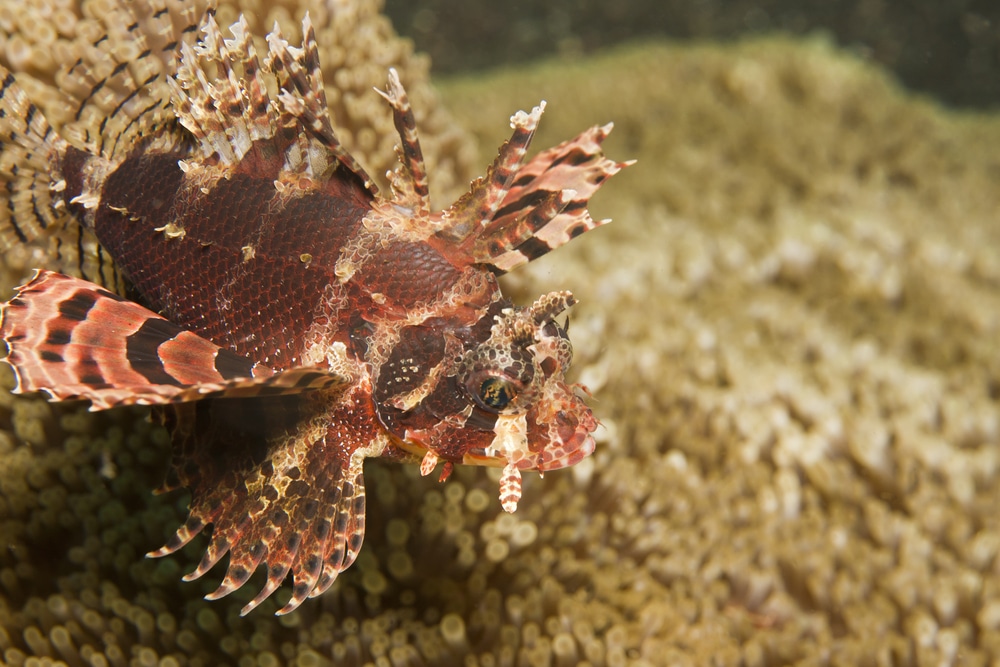
Lionfish (Pteros sp.) are elegant, graceful Scorpionfish (Scorpaenidae) with a hearty appetite. Several of the larger species require large tanks and have a bad habit of eating their tank mates along the way.
The name “Dwarf Lionfish” describes two particular species; the Shortfin or Fuzzy Lionfish (Dendrochirus brachypterus) and the Fu Manchu Lionfish (Dendrochirus biocellatus). Like their larger cousins they have venomous dorsal spines they won’t hesitate to use when feeling threatened.
Medical attention is not usually needed but the wound is very painful. Running the wound under water as hot as you are able to stand neutralizes the venom.
Lionfish are active predators so getting them to feed can be a bit of a challenge. Often when first introduced to a new aquarium they refuse to eat.
Provide meaty items on a feeding stick and dangle and twist in the water. Squid and worms are good at encouraging a feeding response. Over time the lionfish will be trained onto fresh and frozen items.
While they ignore corals and are reef safe, Dwarf Lionfish really aren’t invertebrate safe. They will gladly gulp down shrimp and other mobile invertebrates. And their mouths are a good deal larger than you might expect.
It’s best not to keep even large shrimp with Dwarf Lionfish. They won’t survive if the Lionfish tries and fails to eat them.
Keep in mind this also applies to smaller fish. Anything half their size or under will be eaten. Fish close to their size will be ignored, however.
- Scientific Name: Dendrochirus brachypterus and D. biocellatus
- Length: 4 to 5 inches
- Temperament: Predatory
- Aquarium Size: 30 Gallons
- Reef Safe: With Caution
Threadfin Butterflyfish
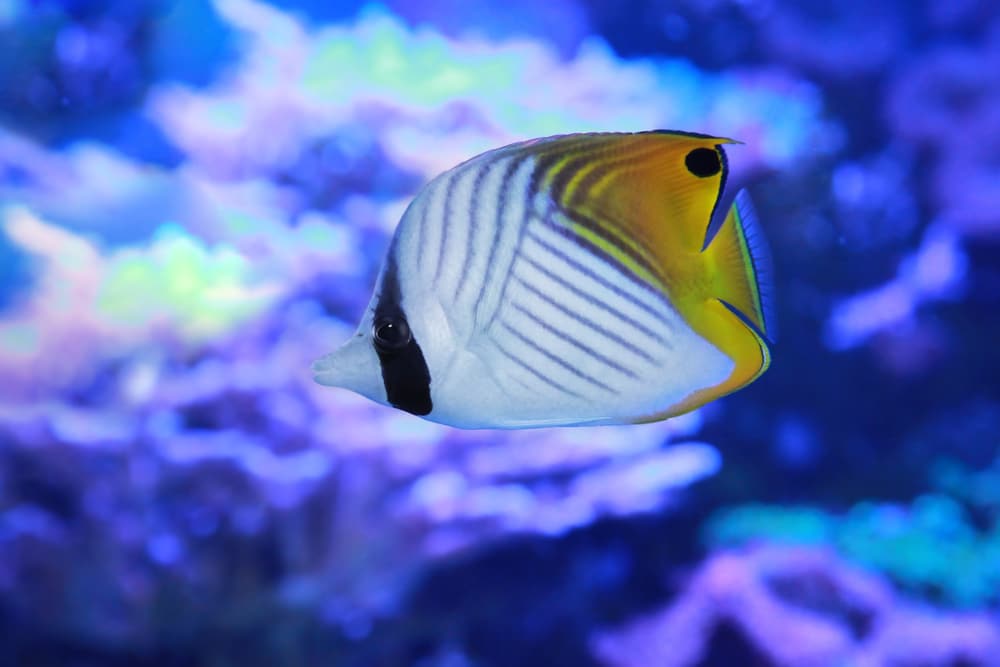
Butterfly fish as a whole tend to be picky, sensitive saltwater aquarium fishes. But the Threadfin Butterflyfish is an exception to the group and a hardy saltwater fish. Found across the Indopacific region, Butterflyfish are close relatives of marine Angelfish and have similar habits.
Butterflyfish are grazers, picking on corals, algae, polyps, and even tiny anemones. As a result they are not reef-safe but do well in fish only aquariums. Threadfin Butterflyfish are peaceful and non-territorial but will chase their own kind and similar looking fish.
Unlike Angelfish, Threadfin Butterflyfish don’t eat much algae and should be offered more meaty fare. They are eager eaters and bold open water swimmers, readily greeting anyone who approaches the tank. Their bold nature and peaceful disposition often encourages shy community dwellers to come out into the open.
- Scientific Name: Chaetodon auriga
- Length: 8 inches
- Temperament: Peaceful
- Aquarium Size: 70 gallons
- Reef Safe: No
Orchid Dottyback
Orchid Dottybacks are common saltwater aquarium fish to find in stores for several good reasons. They are hardy and resistant to nitrogenous waste spikes and other water quality shifts.
Dottybacks are good eaters, beautiful, small, and even spawn in captivity. Does this make the Orchid Dottyback the perfect beginner saltwater fish?
Well…No. They have one bad quality: they are aggressive. Both towards each other and to other saltwater community fish. Keeping them with other semi-aggressive to aggressive fish is best. Or with peaceful species in a larger tank.
Dottybacks prefer carnivorous deities with brine shrimp, bloodworms, and other high protein food. They will eat tiny shrimp but leave larger invertebrates alone.
- Scientific Name: family Pseudochromidae
- Length: 2 to 4 inches
- Temperament: Semi-Aggressive to Aggressive; Territorial
- Aquarium Size: 20+ gallons
- Reef Safe: Yes
Snowflake Eel
Moray eels look intimidating – because they are. But none are too difficult a fish to care for. And the Snowflake Eel is a good marine fish for beginners.
Snowflake Eels are not just hardy; they are one of the smallest moray eels in the world. An adult will be 2 feet long and will live with comfort in 40 to 55 gallons of space.
While they are fish carnivores, Snowflake Moray Eels prefer invertebrates. They have rounded, crunching teeth for breaking into crab and clam shells. Offer them a mixture of invertebrate based foods like shrimp, mussels, squid, and so on.
Such a meaty diet will impact your water quality. So make sure your filter is strong enough to process all of the ammonia that comes from their waste. As well as the food scraps left behind. Well fed Snowflake Eels are not usually aggressive. But a hungry one may try to eat a smaller fish tank mate.
- Scientific Name: Echidna nebulosa
- Length: Up to 24 inches
- Temperament: Semi-Aggressive; Predatory
- Aquarium Size: 40+ gallons
- Reef Safe: No
Diamond Goby
The Diamond Goby deserves a place in any saltwater tank. These fish are sand sifters. They gobble up large mouthfuls of sand, sorting through it for crumbs of food. By sifting sand, they help oxygenate the substrate. Water flow is improved and no patches of decaying food are left behind to turn into ammonia or hydrogen sulfide.
Be careful when aquascaping since a Diamond Goby can destabilize your live rock through digging. They also make a burrow to live in. So give them a substrate that’s around 4 to 6 inches deep.
Diamond Gobies are otherwise easy to keep. You can feed them by injecting small amounts of brine shrimp and other goodies into the sand. The goby will find it over time and consume it, safe from competition with other fish.
- Scientific Name: Valenciennea puellaris
- Length: 5 to 6 inches
- Temperament: Peaceful
- Aquarium Size: 30 gallons
- Reef Safe: Yes
Conclusion
Salt water fish for beginners come in a wide array of forms, sizes, and color patterns. Each one is hardy, easy to find, and small enough to be housed in a regular sized fish tank.
FAQs
Can a Beginner Have a Saltwater Tank?
Saltwater and freshwater tanks have different trade-offs in terms of care. Overall, a saltwater tank is a little more difficult for a beginner. But a well-informed beginner who won’t be lax with water changes and testing will be able to start with one.
Are Saltwater Fish Easy to Care For?
Beginner freshwater fish are hardier when compared to even the most hardy saltwater fish. But that doesn’t mean that there are no saltwater fish that are easy to care for. So long as you are doing regular water changes and maintaining good conditions, dottybacks, damselfish, and other saltwater fish for beginners will thrive.

